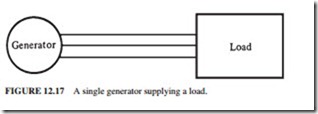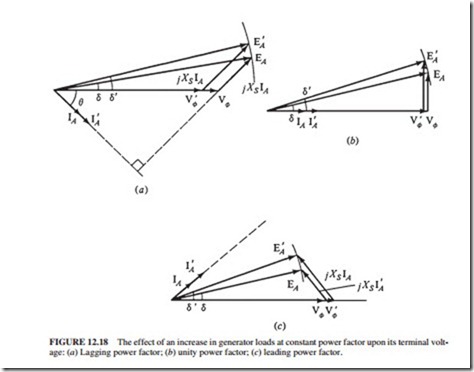THE SYNCHRONOUS GENERATOR OPERATING ALONE
When a synchronous generator is operating under load, its behavior varies greatly depending on the power factor of the load and if the generator is operating alone or in parallel with other synchronous generators.
Throughout the upcoming sections, the effect of RA is ignored, and the speed of the generators and the rotor flux will be assumed constant.
The Effect of Load Changes on a Synchronous Generator Operating Alone Figure 12.17 illustrates a generator supplying a load. What are the effects of load increase on the generator? When the load increases, the real and/or reactive power drawn from the generator increases. The load increase increases the load current drawn from the generator.
The flux cp is constant because the field resistor did not change, and the field current is constant. Since the prime mover governing system maintains the mechanical speed w con- stant, the magnitude of the internal generated voltage EA Kcpw is constant. Since EA is constant, which parameter is varying with the changing load?
If the generator is operating at a lagging power factor and an additional load is added at the same power factor, then the magnitude of IA increases, but the angle e between IA and
Vcp remains constant. Therefore, the armature reaction voltage jXSIA has increased while keeping the same angle. Since
jXSIA must increase while the magnitude of EA remains constant (Fig. 12.18a). Therefore, when the load increases, the voltage Vcp decreases sharply.
Figure 12.18b illustrates the effect when the generator is loaded with a unity power factor. It can be seen that Vcp decreases slightly. Figure 12.18c illustrates the effect when the generator is loaded with leading power factor loads. It can be seen that Vcp increases.
 The voltage regulation is a convenient way to compare the behavior of two generators. The generator voltage regulation (VR) is given by where Vnl and Vfl are the no-load and full-load voltages, respectively, of the generator. When a synchronous generator is operating at a lagging power factor, it has a large positive voltage regulation. When a synchronous generator is operating at a unity power factor, it has a small positive voltage regulation, and a synchronous generator operating at a leading power factor has a negative voltage regulation.
The voltage regulation is a convenient way to compare the behavior of two generators. The generator voltage regulation (VR) is given by where Vnl and Vfl are the no-load and full-load voltages, respectively, of the generator. When a synchronous generator is operating at a lagging power factor, it has a large positive voltage regulation. When a synchronous generator is operating at a unity power factor, it has a small positive voltage regulation, and a synchronous generator operating at a leading power factor has a negative voltage regulation.
During normal operation, it is desirable to maintain the voltage supplied to the load constant even when the load varies. The terminal voltage variations can be corrected by varying the magnitude of EA to compensate for changes in the load. Since EA Kcpw and w remains constant, EA can be controlled by varying the flux in the generator. For example, when a lagging load is added to the generator, the terminal voltage will fall. The field resistor RF is decreased to restore the terminal voltage to its previous level. When RF decreases, the field current IF increases. This causes the flux to increase, which results in increasing EA and, therefore, the phase and terminal voltage.
This process is reversed to decrease the terminal voltage.
